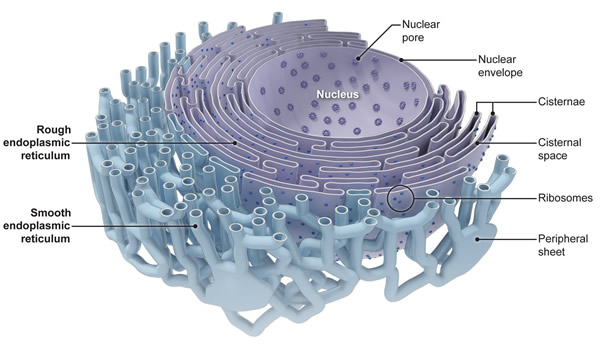 |
| Endoplasmic Reticulum |
The endoplasmic reticulum is a network of sacs in the cytosol of eukaryotic cells that manufactures, processes, transports, and stores chemical compounds for use inside and outside of the cell.
The endoplasmic reticulum (ER) is an extensive, complex system of a more or less continuous distribution of convoluted membrane-bound cavities that take up a sizable portion of the cytosol.
The internal space of the ER is called the lumen. The ER is attached to the double-layered nuclear envelope and provides a connection, or bridge, between the nucleus and the cytosol.
  |
In addition, it provides living bridges between cells by way of the plasmodesmata, small tubes that connect plant cells. The ER is a dynamic structure, constantly changing. It accounts for 10 percent or more of the volume of the cytosol.
In general, there are two kinds of endoplasmic reticulum, rough and smooth. Smooth ER is quite varied in appearance and most likely in function as well. Through a microscope, it appears as numerous nearly circular blotches, indicating that it consists of interlocking tubes of membranes.
On the other hand, rough ER almost always appears as stacks of double membranes that are heavily dotted with ribosomes. Based on the consistent appearance of rough ER, it most likely consists of parallel sheets of membrane, rather than the tubular sheets that characterize smooth ER.
These flattened, interconnected sacs are called cisternae, or cisternal cells. The cisternal cells of rough ER are also referred to as luminal cells. Rough ER and the Golgi complex are both composed of cisternal cells.
Smooth and Rough ER Functions
Because rough ER is covered with ribosomes, it has a bumpy appearance when viewed with an electron microscope. Rough ER is primarily involved in the production of proteins that will be exported from the cell to help with other functions of building the plant. Such proteins include antibodies, digestive enzymes, and certain hormones. Amino acid chains are assembled into proteins by the ribosomes.
The protein units needed outside the manufacturing cell are transported into the rough ER for further processing. Once inside, they are shaped into the correct three-dimensional configuration that will be useful outside the cell. Necessary chemicals, such as carbohydrates or sugars, are then added to complete the proteins.
 |
| Smooth and Rough ER Functions |
The ER then transports these proteins to other areas of the ER, called transitional ER, where they are packed in vesicles to be sent to the Golgi complex for export, or secretion, to other parts of the plant. Occasionally, some of the completed proteins are transported to areas of the manufacturing cell where they are needed.
Because the smooth ER does not have attached ribosomes, it appears relatively smooth when viewed through an electron microscope. It also appears to bud off from vesicles that contain material from the lumen of the ER.
Using the many different enzymes that are anchored to its walls, the smooth ER is involved with the synthesis, secretion, and storage of lipids as well as the manufacture of new membranes and the metabolism of carbohydrates.
Lipids are a group of fatty substances needed for building membranes and storing energy in plants. Among the more important lipids are phospholipids, which make up major components of the cell membrane. When a plant has excess energy available from photosynthesis, it sometimes stores that energy in the form of lipids known as triglycerides.
When the plant is in need of more energy, the triglycerides can be broken down to produce it. Waxes are other important lipids stored in the smooth ER. They form protective coatings on the leaves of plants.Research indicates that smooth ER is also involved in the formation of cellulose for the cell wall.
Other Special ER Functions
Calcium is an essential nutrient for cellular function, growth, and development in plants. However, too much calcium can lead to cell death. To deal with high levels of calcium in the environment, many plants have developed a mechanism involving the ER to regulate bulk quantities of calcium through the formation of calcium oxalate crystals.
Calcium oxalate crystals can account for more than 90 percent of the calcium found in a plant. Certain specialized ER cells, called crystal idioblasts, appear to participate in the formation of calcium oxalate and provide the storage locations for calcium in plants.
Plants have the capability to undergo rapid, large-scale movements when triggered by a wide variety of stimuli, such as changes in light intensity, temperature, and pressure. The ER is the plant sensor for pressure changes. For example, in Venus’s flytrap and in the sensitive plant, the ER in cortex cells, referred to as cortical ER, provides the sense of touch.
Inside the cytosol of these sensor cells, the ER aggregates at the top and the bottom of the cell. When the cells are compressed or squeezed, the cortical ER is strained and releases accumulated calcium, producing the sense of touch. The mechanism is very similar to muscle contraction in an animal.
Because the cortical ER is interconnected through the plasmodesmata, which provide communication channels among cells and end at motor cells in specialized appendages such as pulvini (cushion like swellings at the bases of leaves), flowers, or specialized leaves, a pressure stimulus at one cell can trigger a response throughout the whole plant.